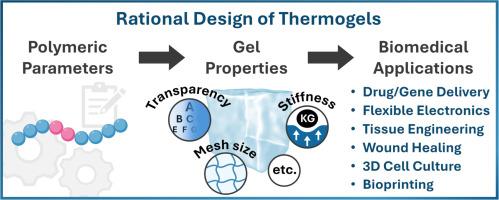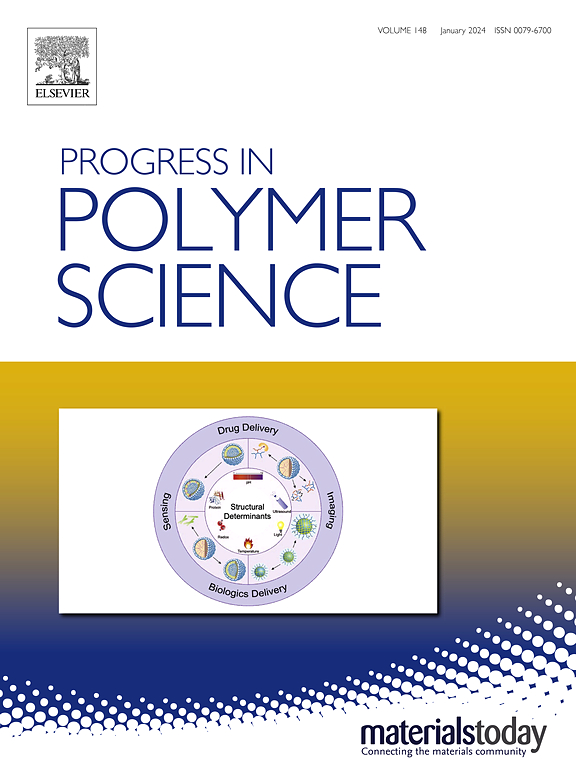高分子热凝胶:合理设计的基础和策略
IF 26.1
1区 化学
Q1 POLYMER SCIENCE
引用次数: 0
摘要
热凝胶是一种很有前途的生物材料,具有实现温度诱导的溶胶-凝胶转变的能力。这种特性使其具有可注射性,促进了一系列生物医学应用的微创管理,包括药物输送,组织工程和伤口愈合。然而,与共价水凝胶相比,它们通过物理交联组装通常会导致较弱的机械性能。多年来,通过利用过去的见解并结合新颖的合成和制造技术,开发出更复杂的热凝胶,成功地产生了各种具有一系列物理化学性质的热凝胶。这使得对热凝胶的物理和化学特性的精确控制成为可能,允许通过合理的设计来定制各种应用。本文将热凝胶的理想品质分为关键的物理和生化性能,强调了它们在性能优化中的重要性。然后,它探讨了研究小组用来精确定制热凝胶特性的各种策略和方法,讨论了从这些结果中获得的见解。最后,对热凝胶的发展前景进行了展望。总之,本文提供的见解将指导热凝胶性能的合理和有针对性的设计,为新兴的生物医学应用及其他领域提供服务。本文章由计算机程序翻译,如有差异,请以英文原文为准。

Polymeric thermogels: Fundamentals and strategies for their rational design
Thermogels are promising biomaterials with the ability to attain temperature-induced sol-gel transitions. This property enables their injectability, facilitating minimally invasive administration for a range of biomedical applications including drug delivery, tissue engineering and wound healing. However, their assembly via physical crosslinks often result in weaker mechanical properties when compared to covalent hydrogels. Over the years, the development of more sophisticated thermogels by leveraging past insights and incorporating novel synthetic and fabrication techniques has successfully resulted in a wide variety of thermogels with a range of physicochemical properties. This has enabled the precise control over the physical and chemical characteristics of thermogels, allowing their customization for various applications through rational design. This review categorizes the desirable qualities of thermogels into key physical and biochemical properties, highlighting their importance in performance optimization. Then, it explores the various strategies and approaches that have been used by research groups to precisely tailor thermogel properties, discussing the insights gained from these results. Finally, the review provides a perspective on the future of thermogel development. Collectively, the insights provided herein will guide rational and targeted design of thermogel properties that serve emerging biomedical applications and beyond.
求助全文
通过发布文献求助,成功后即可免费获取论文全文。
去求助
来源期刊

Progress in Polymer Science
化学-高分子科学
CiteScore
48.70
自引率
1.10%
发文量
54
审稿时长
38 days
期刊介绍:
Progress in Polymer Science is a journal that publishes state-of-the-art overview articles in the field of polymer science and engineering. These articles are written by internationally recognized authorities in the discipline, making it a valuable resource for staying up-to-date with the latest developments in this rapidly growing field.
The journal serves as a link between original articles, innovations published in patents, and the most current knowledge of technology. It covers a wide range of topics within the traditional fields of polymer science, including chemistry, physics, and engineering involving polymers. Additionally, it explores interdisciplinary developing fields such as functional and specialty polymers, biomaterials, polymers in drug delivery, polymers in electronic applications, composites, conducting polymers, liquid crystalline materials, and the interphases between polymers and ceramics. The journal also highlights new fabrication techniques that are making significant contributions to the field.
The subject areas covered by Progress in Polymer Science include biomaterials, materials chemistry, organic chemistry, polymers and plastics, surfaces, coatings and films, and nanotechnology. The journal is indexed and abstracted in various databases, including Materials Science Citation Index, Chemical Abstracts, Engineering Index, Current Contents, FIZ Karlsruhe, Scopus, and INSPEC.
 求助内容:
求助内容: 应助结果提醒方式:
应助结果提醒方式:


